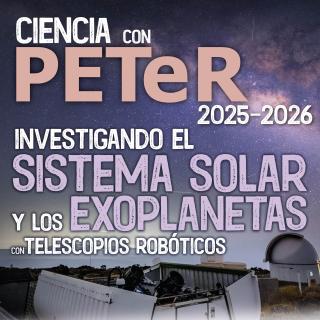It may interest you
-
 The EU-funded EDUCADO project (Exploring the Deep Universe by Computational Analysis of Data from Observations) at the Instituto de Astrofísica de Canarias (IAC) is organising a two-night astronomical observation school providing hands-on research training for early-stage researchers in astronomy and computer science. The program will convene 15 doctoral candidates from across Europe for an immersive, interdisciplinary learning experience. Attendees will engage in night time astronomical observations utilizing state-of-the-art telescopic instrumentation, guided data analysis workshops, andAdvertised on
The EU-funded EDUCADO project (Exploring the Deep Universe by Computational Analysis of Data from Observations) at the Instituto de Astrofísica de Canarias (IAC) is organising a two-night astronomical observation school providing hands-on research training for early-stage researchers in astronomy and computer science. The program will convene 15 doctoral candidates from across Europe for an immersive, interdisciplinary learning experience. Attendees will engage in night time astronomical observations utilizing state-of-the-art telescopic instrumentation, guided data analysis workshops, andAdvertised on -
 El Instituto de Astrofísica de Canarias (IAC) y el Área STEAM para el Fomento de las Vocaciones Científicas y la Creatividad de la Consejería de Educación, Formación Profesional, Actividad Física y Deportes del Gobierno de Canarias anuncian el lanzamiento de un ambicioso proyecto de innovación educativa, Ciencia con PETeR: Investigando el Sistema Solar y los exoplanetas con telescopios robóticos. Esta iniciativa, dirigida a centros de Educación Secundaria Obligatoria y Bachillerato del archipiélago, convertirá a las aulas canarias en auténticos centros de investigación astronómica durante elAdvertised on
El Instituto de Astrofísica de Canarias (IAC) y el Área STEAM para el Fomento de las Vocaciones Científicas y la Creatividad de la Consejería de Educación, Formación Profesional, Actividad Física y Deportes del Gobierno de Canarias anuncian el lanzamiento de un ambicioso proyecto de innovación educativa, Ciencia con PETeR: Investigando el Sistema Solar y los exoplanetas con telescopios robóticos. Esta iniciativa, dirigida a centros de Educación Secundaria Obligatoria y Bachillerato del archipiélago, convertirá a las aulas canarias en auténticos centros de investigación astronómica durante elAdvertised on -
 El IAC colabora por segundo año consecutivo con el festival de música y tendencias de Puerto de la Cruz con actividades gratuitas que permitirán a los asistentes descubrir el Observatorio del Teide y observar el Sol con telescopios especializados. El Instituto de Astrofísica de Canarias (IAC) se suma nuevamente al Phe Festival , que celebra su décimo aniversario los días 5 y 6 de septiembre en Puerto de la Cruz, con un programa de actividades destinadas a acercar la Astronomía y la investigación científica al público general. La iniciativa forma parte de IAC POP, la estrategia de divulgaciónAdvertised on
El IAC colabora por segundo año consecutivo con el festival de música y tendencias de Puerto de la Cruz con actividades gratuitas que permitirán a los asistentes descubrir el Observatorio del Teide y observar el Sol con telescopios especializados. El Instituto de Astrofísica de Canarias (IAC) se suma nuevamente al Phe Festival , que celebra su décimo aniversario los días 5 y 6 de septiembre en Puerto de la Cruz, con un programa de actividades destinadas a acercar la Astronomía y la investigación científica al público general. La iniciativa forma parte de IAC POP, la estrategia de divulgaciónAdvertised on
